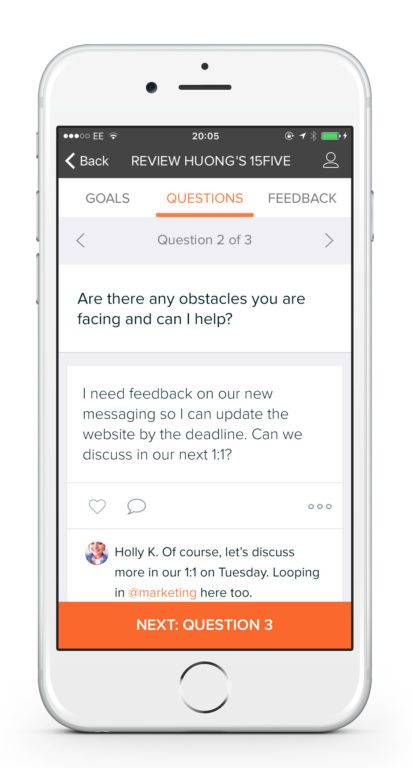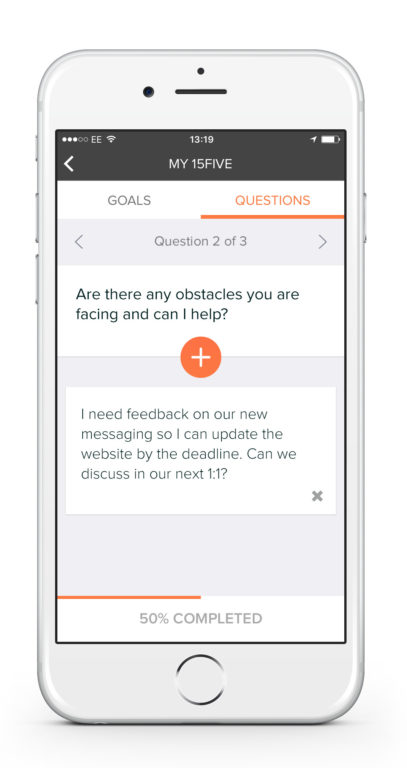How To Manage Your Remote Team From (Almost) Anywhere
Let’s face it, remote work is an enduring reality at this point. Among other reasons, a remote team allows employers to find the best talent and allows managers to be flexible about coming into the office themselves.
For the modern workforce, this isn’t just a nice to have. An Ernst and Young study conducted in 2015 found that near the top of concerns for employees seeking a new job was, “being able to work flexibly and still be on track for promotion”.
But how do you manage a remote or distributed team? How can you motivate, offer support, and maintain alignment around goals with employees that you may never even see?
Tech To The Rescue
Equally enduring (and growing!) is the proliferation of mobile devices, which are enabling businesses to support remote work. As an example, talent management expert, Josh Bersin predicts that “employee feedback apps…are powerful and disruptive, and they have the potential to redefine how we manage our organizations.”
This post is about the technology we have created to help managers and employees communicate about what’s most important from nearly anywhere. But no matter what tech you use, the process outlined below can benefit any team.
The RemoteCEO
It’s no secret that we did not invent 15Five (although we believe that we have perfected the weekly check-in). The idea originated in the 1980s with ESPRIT founder Doug Tompkins, who shared it with Yvon Chouinard, founder of Patagonia. Integral to that company’s success, was Chouinard’s ability to regularly climb, surf, and spend time in nature. You can’t innovate at an outdoor clothing and gear company, unless you actually go outdoors.
Chouinard presumably used a phone or fax machine to receive a distilled update about what was happening at the office, but providing feedback to managers and employees was far from real-time. That method would never work today, when conversations need to be more frequent, and decisions need to be made rapidly for companies to stay competitive.
Our co-founder and CEO, David Hassell, managed 15Five remotely for over a year with the help of apps like Zoom, Trello, Google Drive, and our very own employee feedback software. He explained the power of these apps in this Venture Beat article: “If people are off-track or out of alignment with company goals, I can see right away, and respond quickly to get them back on course.”
Our desktop application allows for regular communication so that modern companies can stay nimble, but you can’t exactly take a laptop onto a ski-lift or on a hike — believe me, I’ve tried. Now managers and employees who prefer flexibility to being at a desk, can stay in touch from anywhere with the 15Five iOS app.
2019 Update: Our Android App is now live! 15Five Lite makes it simple for managers and executives to stay up-to-date with their team’s wins, challenges, goals, and the overall pulse of the organization. You can now read and review 15Fives, leave comments, @mention others, pass up answers, and add employee answers to 1-on-1s, all from your Android device.
Three Steps To Remote Team Success
A recent study showed how reflecting on our work and keeping a “done list” can significantly improve learning and performance. One of the study authors, Professor Francesca Gino, stated that we have a bias for completion. Employees who checked items as complete were 30% more productive and experienced greater enjoyment in their work.
The “Goals” tab allows employees to enter their most important tasks for the upcoming week. Next week they can check off the goals that they accomplished, and can leave comments to provide other details about their progress. They can even add additional accomplishments at the bottom that were not contemplated the week before. Managers get a sense of progress at a glance and can also comment to applaud wins and ask for detail on failures.
2) Employee Q&A 
Remote work works, but not in a vacuum. Consistent communication is a crucial component for any high-functioning remote team. Asking questions at a regular cadence allows managers to create a culture where employees feel heard, stay productive, and remain accountable, even from far away.
Don’t worry if you’re not sure what to ask. Here is a great question to get you started: How have you improved your remote working skills this month? Have you identified any challenges? Or check out these 10 Questions to Keep Your Remote Team Focused on Their Work.
3) Manager Feedback
 Employee feedback is a two-way process, and not responding to employee answers is a recipe for disaster. People want to feel heard when they have problems and seen when they have triumphs. Managers can comment on answers directly in the app, spawning important conversations about everything from increasing revenue to improving company-wide processes.
Employee feedback is a two-way process, and not responding to employee answers is a recipe for disaster. People want to feel heard when they have problems and seen when they have triumphs. Managers can comment on answers directly in the app, spawning important conversations about everything from increasing revenue to improving company-wide processes.
When employees don’t get the support they need, or managers don’t share in their successes, satisfaction and morale can plummet. Before employees share an issue, they might assume that their manager doesn’t know about it. But once they share and don’t receive an acknowledgement in return, they will assume that their manager just doesn’t care.
For more on managing remote teams check out Zapier’s Ultimate Guide To Remote Work.





